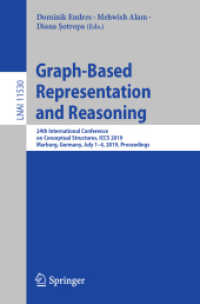- ホーム
- > 洋書
- > 英文書
- > Science / Mathematics
Full Description
Having edited "Journal of Materials Processing Technology" (previously entitled "Journal of Mechanical Working Technology") for close on 25 years, I have seen the many dramatic changes that have occurred in the materials processing field. Long gone are the days when the only "materials processing" carried out was virtually the forming of conventional metals and alloys, and when the development of a new product or process in a great number of cases called for several months of repetitive trial-and-error,' with many (mostly intuition- or experience-based) expensive and time-consuming modifications being made to the dies, until success was achieved. Even when a 'successful' product was formed, its mechanical properties, in terms of springback and dimensional accuracy, thickness variations, residual stresses, surface finish, etc. , remained to be determined. Bulk-forming operations usually required expensive machining to be carried out on the product to impart the required dimensional accuracy and surface fmish. Over the years, the experience-based craft of metal forming has given way to the science of materials processing. With the use of the computer, forming operations can be simulated with accuracy, to determine the best forming route and the associated forming loads and die stresses, and to predict the mechanical properties of the formed product, even down to its surface texture.
Contents
1 Introduction to near net-shape operations.- 1.1 Introduction.- 1.2 Classification of near net-shape operations.- 1.3 Near net-shape operations: past, present and future.- 2 CAD/CAM for sheet metal forming and related processes.- 2.1 Introduction and basic techniques.- 2.2 Optimisation of blank layout.- 2.3 Fine blanking.- 2.4 Progressive stamping.- 2.5 An overview of a flat patterning and bending simulation system.- 2.6 CNC punching and nibbling.- 2.7 Die construction design.- 2.8 NC programming of wire EDM.- References.- 3 CAD/CAM for massive (bulk) metal forming.- 3.1 Introduction.- 3.2 Cold upsetting.- 3.3 Closed-die forging.- References.- 4 CAD/CAE/CAM for injection moulding.- 4.1 Introduction.- 4.2 Graphic input and geometry construction of injection moulded products.- 4.3 CAD for construction design of plastic injection moulds.- 4.4 Flow simulation of plastic injection moulding.- 4.5 Cooling simulation of plastic injection moulding.- 4.6 CAM for plastic injection moulds.- 4.7 CAD/CAE/CAM system for plastic injection moulding.- 5 FEM applications in near net-shape operations.- 5.1 Introduction.- 5.2 FEM applications and developments in near net-shape operations.- 5.3 FEM applications in massive (bulk) metal forming processes.- 5.4 FEM application in die design.- 5.5 FEM application in analysis of hydraulic presses.- 6 CAE/CNC of machines for near net-shape operations.- 6.1 Introduction.- 6.2 Universal CNC systems for near net-shape operations.- 6.3 CNC for sheet metal forming machines.- 6.4 FMC for sheet metal bending.- 7 IMOLD®: an intelligent mould design and assembly system.- 7.1 Introduction.- 7.2 Injection moulding.- 7.3 Computer applications in injection mould design.- 7.4 IMOLD®.- 7.5 An example.- 7.6 Conclusions.- References.- 8 Computer applications inintelligent progressive dies design (IPD).- 8.1 Introduction.- 8.2 Overview of the computer architecture.- 8.3 Advanced knowledge-based techniques for the modelling and generation of progressive dies.- 8.4 An industrial case study.- 8.5 Conclusions.







